Distributed Concurrent Runs
When performing concurrent MRM runs consisting of many runs, the following are some problems that users encounter:
• The memory required may exceed the resources available and/or
• The time required to make the runs is excessive.
This section describes a utility that solves these two issues by distributing many runs across many processors on the same machine.
Note: All runs are made on the same computer that has multiple cores or multiple logical processors. In this document, each separate MRM instance is referred to as a simulation processor.
In this approach, there is a controller processor and simulation processors. The controller processor does the following:
1. Creates the configurations
2. Controls execution (Start and Stop) of each simulation.
3. Tracks the progress.
4. When all the runs are finished, combines the output RDF file from each simulation into one output RDF file.
Figure 3.8
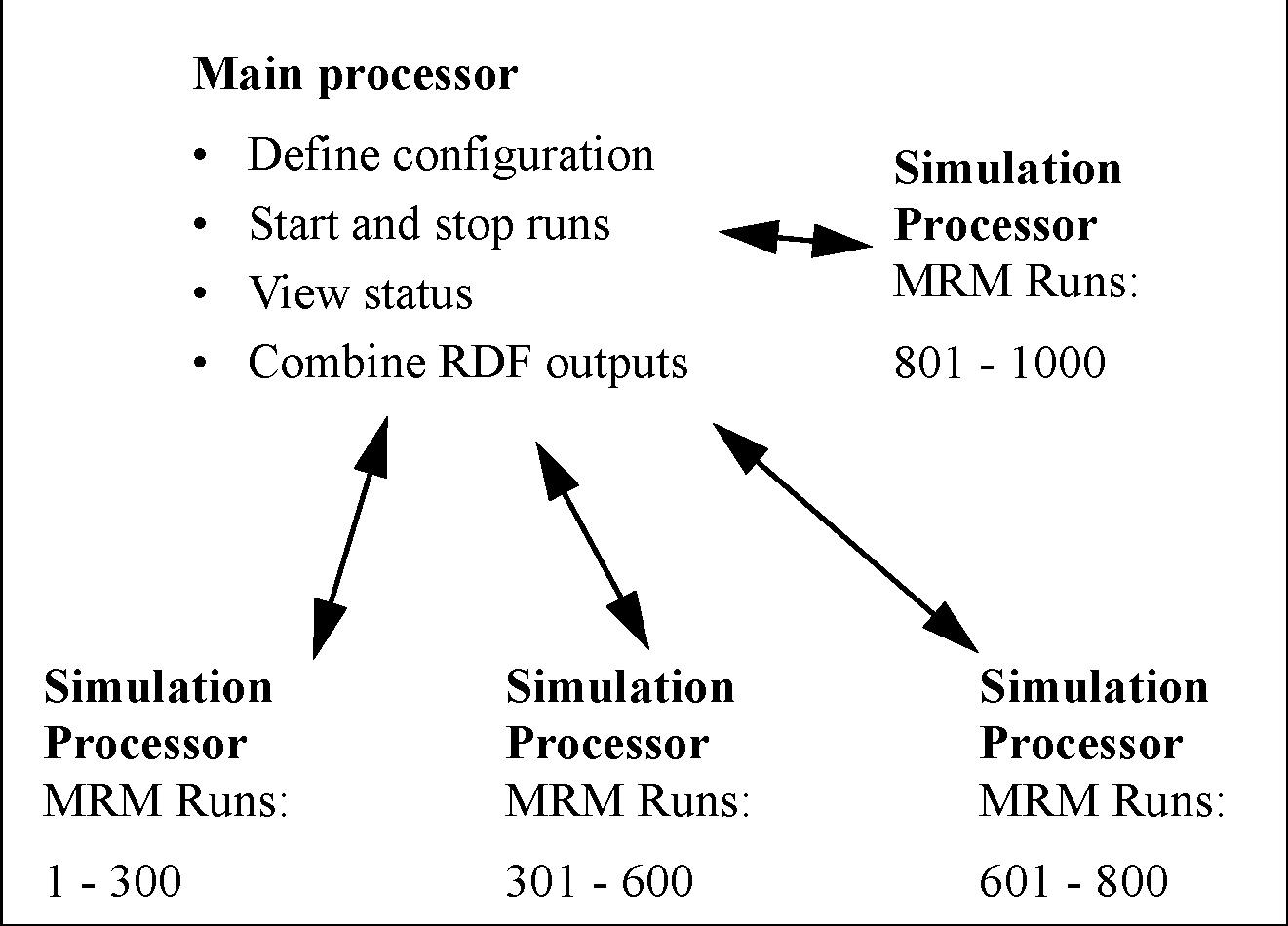
Each simulation processor then executes the MRM runs that the controller gives it to execute. Each processor runs one or more MRM runs that consist of a portion of the total number of concurrent runs. This is shown graphically in the screenshot. In this example, there are 1000 runs that are distributed unequally to four processors.
Note: If you are running RiverWare using a floating license, you can only run as many RiverWare sessions as your license allows. For example, a three-seat floating license can only run 3 RiverWare sessions. Therefore, you can distribute an MRM run to only three processors. If you wish to distribute to more processors, check out a roaming license. Node-locked and roaming licenses can run unlimited RiverWare sessions. The license guides can be found at the following URL:
This feature was initially designed for a very specific application of concurrent MRM. As such, the following are the limitations and constraints:
• The same version of RiverWare must be used for each run.
• In the MRM configuration, the Inputs must be Traces or Index Sequential with the Pairs mode selected. See Combined Runs for details.
• Input DMIs can include Control File-Executable or Excel Database DMIs with the Header approach. If using Excel, you must use the Trace configuration option for the Run Names. The Run option is not supported.
Figure 3.9
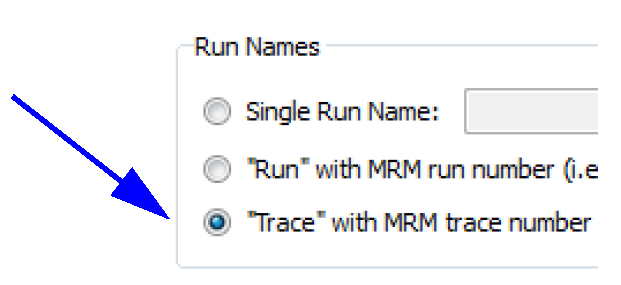
• Only a single ruleset may be used.
This document is organized to present an overview of the user interface, how to make a run, and how the utility works to distribute the runs.
User Interface Overview
The interface for distributing MRM runs across multiple simulations consists of two components, the MRM configuration within RiverWare and the Distributed MRM dialog which is external to RiverWare.
MRM Configuration
MRM runs can only be distributed when in Pairs mode; see Combined Runs. Thus, when in Pairs mode, the Input tab has a Distributed Runs checkbox that becomes enabled. When checked, the Distributed Runs tab is added to the dialog.

As discussed in the sections that follow, the Distributed Runs tab allow you to configure:
• The working directory.
• Whether the configuration should be saved to a file.
• The number of multiple runs to distribute the traces across.
• Environment variables and their values.
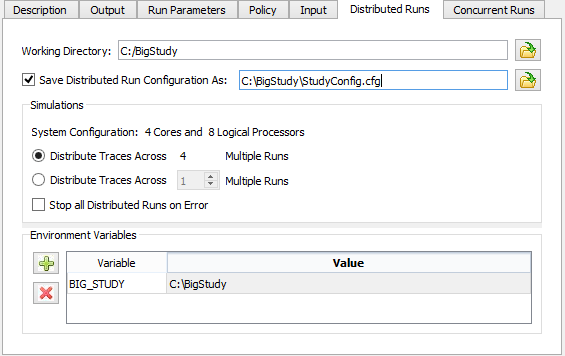
Working Directory
A distributed concurrent run creates several working files - batch script files, control files, intermediate RDF files and log files among them. The working directory specifies where the working files will be created. Importantly, it should be a directory which the controller processor and all simulation processors have access to (via the same path).
Save Configuration As
When a distributed concurrent run is started, RiverWare writes a configuration file, invokes the Remote Manager process, and exits. If a user elects to save the configuration to a named file, it is possible to invoke the Remote Manager directly bypassing RiverWare. See Creating or Changing a Configuration for details.
Simulations
The Simulations section defines the simulation processors and the traces they will simulate.
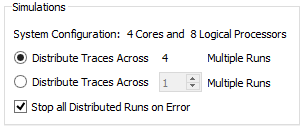
The System Configuration line provides the number of cores and the number of logical processors on the machine. You can distribute your runs as follows:
• Distribute Traces across N Multiple Runs. Use all available cores on the machine. The model can be moved to different computers and the configuration will use all of the cores.
• Distribute Traces across <N> Multiple Runs. Specify the distribution. Specify a set number of runs so the runs complete in a reasonable amount of time without using all of a computer's resources. Or if you have a lot of RAM, you may specify a larger number, likely up to the number of logical processors.
The choice is ultimately hardware and model dependent. To make the best choice you will need to have detailed knowledge of your model’s memory usage and hardware. Tools like SysInternals may help to identify the maximum working set when running the model. Experimentation may be necessary to determine the most efficient settings.
Finally, in this section is a control to Stop all Distributed Runs on Error. When checked, if one distributed run aborts, the remaining distributed runs will also be stopped. This prevents having to wait for all runs to finish when one has failed and the results are not valid. See also Concurrent Runs for more information on a control to allow a set number of individual runs/traces to abort before aborting all runs. Setting the run limit to 1 has the same affect as checking the box for distributed runs, either will stop all simulations when one simulation fails. Note, the run limit takes precedence, as it will stop all simulations even if the box isn't checked. The one area where the Stop all Distributed Runs on Error check box is relevant is when a multiple run aborts outside of a simulation (for example, when writing the RDF output).
Environment Variables
You can enter environment variables and value pairs.
Remote Manager and Status Dialog
As mentioned above, the Remote Manager includes a user interface which displays the status of the simulations. This dialog is not within RiverWare but is a separate executable in the installation directory. It is also opened automatically when you make a distributed MRM run from the RiverWare MRM Run Control. More specifically, the Remote Manager user interface allows you to:
• Start and stop the simulations individually or collectively.
• View RiverWare’s diagnostic output for the simulations.
• View the multiple and single run status.
• See an estimated time remaining.
• See the status of the post-processing (combining the RDF files).
In Figure 3.10, from left to right, are the Process Status, Multiple Run Status, and Single Run Status panels.
Figure 3.10
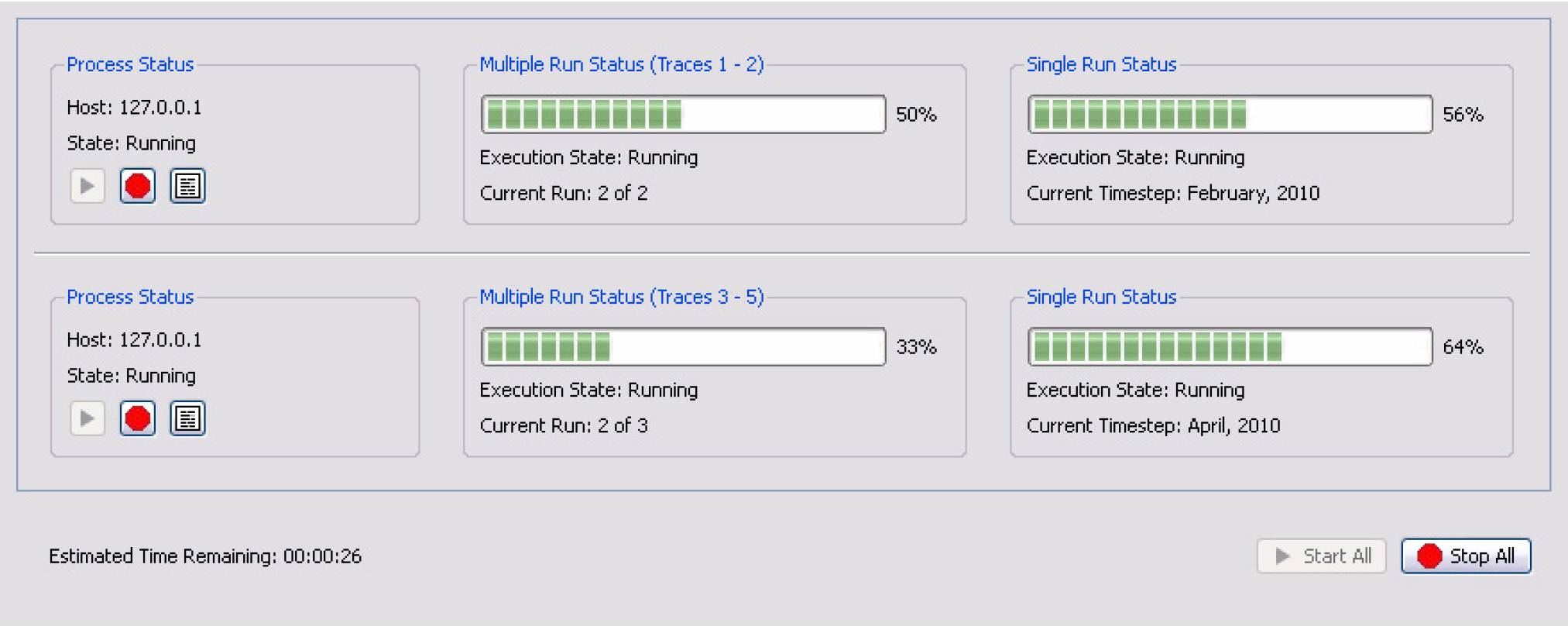
The Process Status panel includes the Start, Stop, and View Diagnostics buttons. The buttons allow you to start, stop, and view diagnostics for the individual run/process.
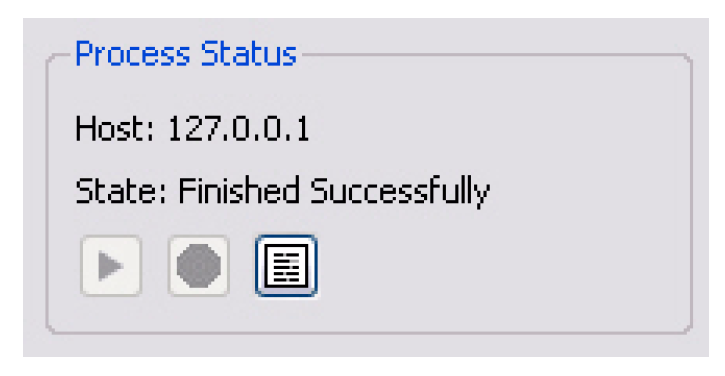
The Multiple Run Status and Single Run Status panels (which are very similar to RiverWare’s run status dialog) display the progress of each MRM run and each individual run:

The bottom of the dialog shows the estimated time remaining based on available data after the first run has completed.

How to Make a Distributed Run
There are two options, creating/changing the configuration (within RiverWare) or rerunning a configuration (can be external to RiverWare). These are described in the next two sections:
Creating or Changing a Configuration
If you are creating a new configuration or changing an existing configuration, the changes must be made from within RiverWare. This will allow RiverWare to create the necessary configuration files that will be passed to the simulation controllers. When you select Start, RiverWare will create the necessary configuration files, start the RiverWare Remote Manager, and then exit. The RiverWare Remote Manager controls the execution of the MRM runs.
Use the following steps to make the runs in this case:
1. Open RiverWare.
2. Fully define the configuration or make any changes to an existing configuration in the MRM Run Control Configuration dialog. See User Interface Overview for the options.
3. Apply the changes.
4. SAVE THE MODEL. The distributed runs open and run the model that is saved on the file system. Therefore, you should save the model now, so that the configuration is preserved. Any changes to the model (including external files such as the RDF control file) will invalidate the saved configuration file.
5. Select Start on the Multiple Run Control Dialog. RiverWare will start the Remote Manager and then start the shutdown sequence. It will prompt you for confirmation so you can cancel at any time.
6. From the Remote Manager, select Start to start the distributed runs. See Remote Manager and Status Dialog for details.
7. The individual runs start and the status is shown including an estimate of the time remaining.
8. When all runs are complete, the output RDF files are combined into one final RDF file.
Rerunning a Configuration
If you are repeating a previously saved configuration, then you can execute the RiverWare Remote Manager directly and not open the RiverWare. In that case, you start at Step 6.. The Remote Manager will first open a simple dialog allowing you to select the configuration file and will then open its user interface. See Save Configuration As for details.
How It Works
Figure 3.11 illustrates the distributed architecture. In the distributed architecture there is a controller processor and one or more simulation processors.
The distributed architecture includes two processes - the RiverWare Remote Manager (RwRemoteMgr.exe) and instances of RiverWare (RiverWare.exe).
Figure 3.11
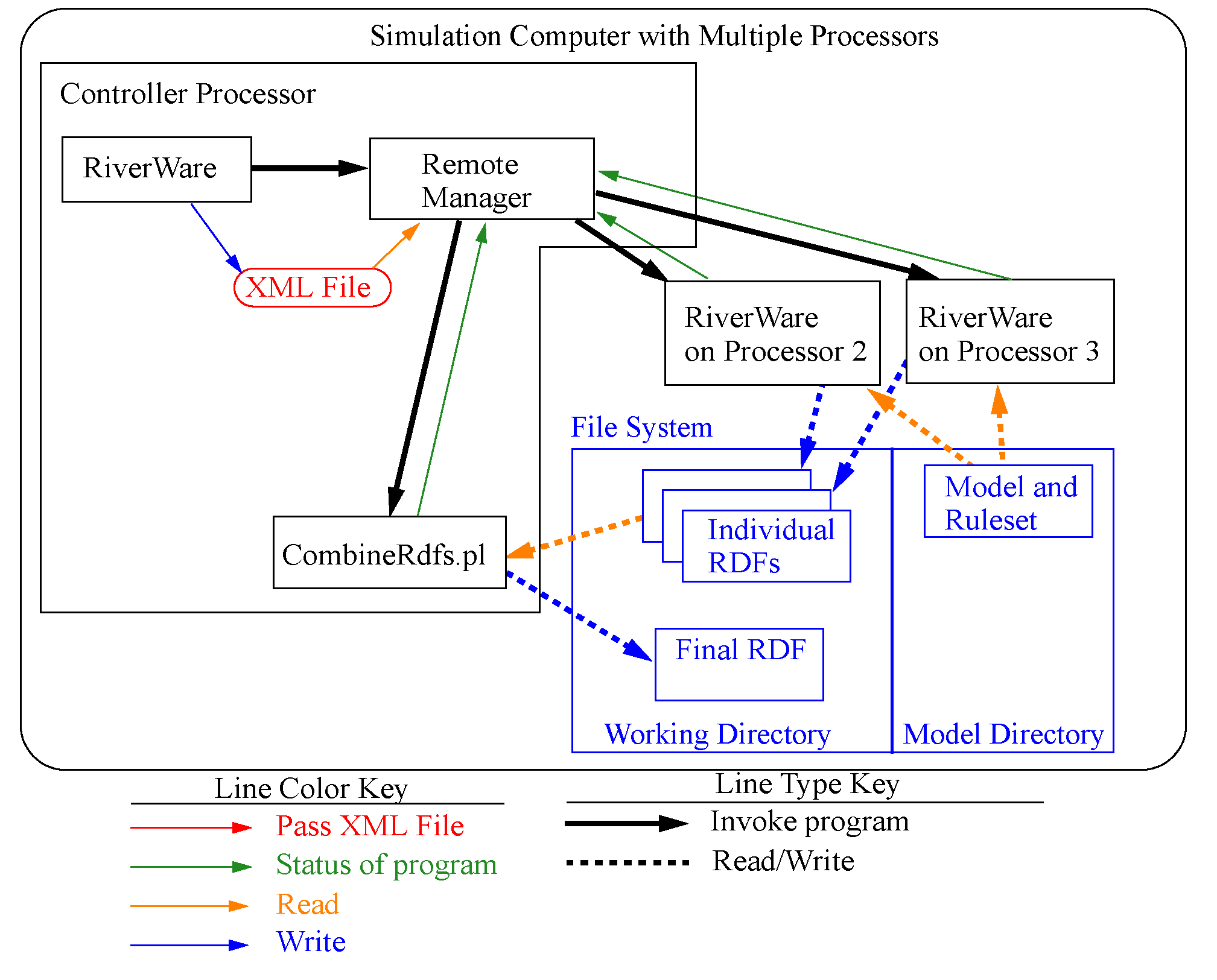
RiverWare Remote Manager
The RiverWare Remote Manager parses an XML configuration file that defines the simulations and:
• Creates an XML configuration for each of the simulations.
• Configures its user interface (a dialog which shows the status of the simulations).
• For each simulation, connects to the simulation processor, writes the XML configuration, and reads RiverWare’s output (which it uses to update its status dialog).
• When all simulations have finished, combines the partial RDF files to create the final RDF files.
XML Configurations
Previous sections have referred to XML configurations. These are the files that RiverWare creates to control/define the distributed MRM runs.
Note: This section is a technical reference providing more information on how this utility works. The XML files are generated by the utility and the user does not need to edit these files to make a distributed MRM run.
The top-level XML configuration <distrib> identifies a distributed concurrent run and is hereafter referred to as the distributed configuration. An XML document defining a distributed concurrent run would have the following top-level elements:
<document>
<distrib>
...
</distrbv>
</document>
The XML document defining a distributed concurrent run is created by RiverWare when a user starts the run. DistribMrmCtlr parses the distributed configuration and creates a configuration for each of the simulations. Some elements are from the MRM configuration, others are provided by RiverWare. Some elements are common to all simulations, others are unique to each simulation.
Example 3.1 Sample XML File
Key elements in this example are preceded by brief descriptions.
<distrib>
The RiverWare executable which started the distributed concurrent run. The assumption is that all simulations use the same executable.
<app>C:\Program Files\CADSWES\RiverWare 6.4\riverware.exe</app>
The model loaded when the user starts the distributed concurrent run.
<model>R:\\CRSS\\model\\CRSS.mdl</model>
The global function sets loaded when the user starts the distributed concurrent run.
<gfslist>
<gfs>R:\\CRSS\\model\\CRSS.gfs</gfs>
</gfslist>
The config attribute is the MRM configuration selected when the user starts the distributed concurrent run. The mrm elements are from the MRM configuration and identify for each simulation the traces to simulate.
<mrmlist config=”Powell Mead 2007 ROD Operations”>
<mrm firstTrace=”1” numTrace=”200”/>
<mrm firstTrace=”201” numTrace=”200”/>
</mrmlist>
The rdflist element is a list of the final RDF files, while the slotlist element is a list of the slots which are written to the RDF files. Slots can be written to multiple RDF files; they’re associated with the RDF files by the idxlist attribute, whose value is a comma-separated list of RDF file indices. RiverWare initializes the RDF DMI and mines its data structures to generate rdflist and slotlist.
<rdflist num=”2”>
<rdf name=”R:\\CRSS\\results\\Res.rdf” idx=”0”/>
<rdf name=”R:\\CRSS\\results\\Salt.rdf” idx=”1”/>
</rdflist>
<slotlist>
<slot name=”Powell.Outflow” idxlist=”0,1”/>
<slot name=”Powell.Storage” idxlist=”0”/>
</slotlist>
The envlist element specifies RiverWare’s runtime environment; RIVERWARE_HOME is from the version of RiverWare which starts the distributed concurrent run, all others are from the MRM configuration.
<envlist>
<env>RIVERWARE_HOME_516=C:\\Program Files\\CADSWES\\RiverWare 5.1.6 Patch</env>
<env>CRSS_DIR=R:\\CRSS</env>
</envlist>
The tempdir element is from the MRM configuration and is the intermediate directory where the individual simulations write the partial RDF files.
<tempdir>R:\\CRSS\\temp</tempdir>
</distrib>
Revised: 08/02/2021